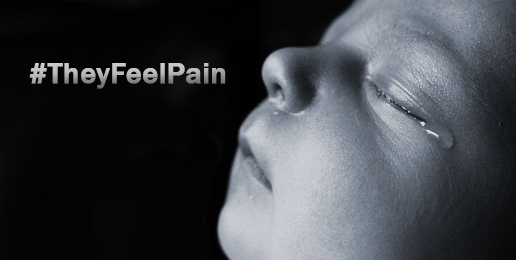
Every year in America, more than 18,000 perfectly healthy babies – developed enough to feel pain and, in many cases, survive outside the womb – are brutally killed in their mother’s wombs.
Eighteen thousand.
Can you imagine the public outrage if 18,000 babies died every year from faulty baby formula or substandard infant car seats? Liability lawsuits would flood the court systems and manufacturing companies would shutdown in bankruptcy and disgrace.
These particular 18,000 babies have been growing for 20 weeks or more in their mother’s bodies.
“These are innocent and defenseless children who can not only feel pain, but who can survive outside of the womb in most cases, and who are torturously killed without even basic anesthesia. Many of them cry and scream as they die, but because it is amniotic fluid going over their vocal cords instead of air, we don’t hear them, ” U.S. Representative Trent Franks of Arizona told LifeSite News this week.
Eighteen thousand innocent babies.
Next Wednesday, 42 years after the U.S. Supreme Court’s Roe vs Wade decision legalizing abortions for any reason up to the moment of birth, Franks and U.S. Representative Marsha Blackburn (R-TN) will ask their Congressional colleagues in the U.S. House to vote on H.R. 36 – a federal measure to protect those 18,000 innocents from painful, violent deaths.
Franks and Blackburn expect to be joined by nearly 180 other House members who will co-sponsor the measure.
Five Illinois Congressmen have signed on thus far as co-sponsors, four Republicans: Randy Hultgren (Geneva), Peter Roskam (Barrington), Aaron Schock (Peoria) and John Shimkus (Effingham) and one Democrat: Dan Lipinski (Chicago).
Three Republican House members have yet to commit on the bill: Adam Kinzinger (Rockford) and newbies Mike Bost (Murphysboro) and Bob Dold (Mundelein). Historically the remaining Democratic members of Illinois’ delegation have supported abortion advocates’ position.
Abortion defenders are holding the line against any restrictions whatsoever. They deny the medical studies showing 20 week old preborn babies can feel pain.
“The studies are pretty clear — at 20 weeks, there is no indication that nerves are developed. Abortion is really rare past 20 weeks and is incurred because of a set of complex circumstances,” Jamila Perritt, MD, medical director of Planned Parenthood of Metro Washington, D.C., said at a press conference this week.
In response, numerous brain and nerve activity experts cite the need for prenatal surgeons to anesthetize their patients during in utero surgical procedures.
“To experience pain an intact system of pain transmission from the peripheral receptor to the cerebral cortex must be available. Peripheral receptors develop from the seventh gestational week,” Marc Van de Velde and Frederik De Buck wrote in, “Fetal and Maternal Analgesia/Anesthesia for Fetal Procedures”:
From 20 weeks’ gestation peripheral receptors are present on the whole body. From 13 weeks’ gestation the afferent system located in the substantia gelatinosa of the dorsal horn of the spinal cord starts developing. Development of afferent fibers connecting peripheral receptors with the dorsal horn starts at 8 weeks’ gestation. Spinothalamic connections start to develop from 14 weeks’ and are complete at 20 weeks’ gestation, whilst thalamocortical connections are present from 17 weeks’ and completely developed at 26–30 weeks’ gestation. From 16 weeks’ gestation pain transmission from a peripheral receptor to the cortex is possible and completely developed from 26 weeks’ gestation.
Numerous other doctors have filled in about prenatal infants’ pain capability and made their testimony available at www.doctorsonfetalpain.com.
Medical science is convincing the American public that preborn babies can indeed feel pain. In a March 2013 survey by The Polling Company, 64 percent of 1003 registered voters said they would support a law such as the Pain-Capable Unborn Child Protection Act prohibiting abortion after 20 weeks — when an unborn baby can feel pain — unless the life of the mother is in danger. Less than a third opposed such legislation.
It’s very likely Franks and Blackburn’s H.R. 36 will pass the U.S. House as the nation remembers the U.S. Supreme Court’s Roe vs Wade decision. It could also pass the U.S. Senate in the days after.
However, Congress.gov says the measure has less than a five percent chance to be implemented because it’s unlikely President Barack Obama, who hailed the practice of Partial Birth Abortion, would ever sign abortion restrictions into law.
And what about the chances of overriding an Obama veto?
“I’m told there is no way there are 60 votes to override a veto in the Senate,” said nationally-popular prolife blogger Jill Stanek.
So why try to so hard pass legislation that won’t become law?
“We just keep pushing, educating, making a big deal out of the humanity of preborn babies and pain,” Stanek said. “This will be similar to when [former President Bill] Clinton vetoed the Partial Birth Abortion Ban twice.”
The Partial Birth Abortion Ban was finally signed into law by President George W. Bush November 5, 2003 – nearly eight years after the first version was introduced.
H.R. 36 prohibits an abortion from being performed if the pain-capable child is 20 weeks or more, except when a mother’s life is endangered, or the pregnancy is the result of reported rape or incest.
How can anyone oppose saving those 18,000 innocent babies’ lives and protecting them from potential inhumane pain and suffering?
On the other hand, perhaps we should ask ourselves how we could ever explain to future generations how we didn’t even try.
Take ACTION: Click HERE to send a message to your U.S. Representative asking them to support H.R. 36, the Pain-Capable Unborn Child Protection Act. Or call the Capitol Switchboard to ask to be connected to your U.S. Representative’s office: 202-224-3121.
If you live outside of Illinois, Click HERE to send an email through the National Right To Life Committee’s web site.
The Truth Project
First Annual IFI Worldview Conference
featuring Dr. Del Tackett
April 10-11, 2015
CLICK HERE for Details






















